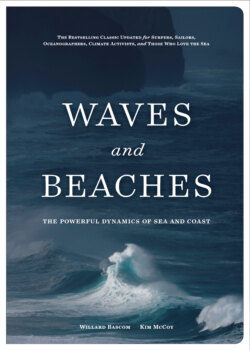Читать книгу Waves and Beaches - Kim McCoy - Страница 36
На сайте Литреса книга снята с продажи.
SWELL
ОглавлениеAs waves move out from under the winds that generated them, their character changes. The original wind waves are said to decay, meaning the crests become lower, more rounded, and more symmetrical. They move in groups of similar period and height, and their form approaches that of a true sine curve. Such waves are now called swell, and in this form they can travel for thousands of miles across deep water with little loss of energy.
In more formal language, these waves are “periodic disturbances of the sea surface under the control of gravity and inertia and of such height and period as to break on a sloping shoreline.”
The usual range of period of swell is from six to sixteen seconds, but occasionally longer periods are clocked. The average period of the swell arriving at the US Pacific coast is slightly longer than measured in the Atlantic. This difference arises partly from the much greater size of the Pacific, in which longer waves can be generated in larger storm areas, and partly from the greater distances the waves must travel across the Atlantic continental shelf before they reach the shore—in which the longer-period waves are attenuated.
As swell, the waves have relationships conforming rather closely to the simple equations that applied in the wave channel. That is, their wave length L is about 5.12 T2, where T is the wave period in seconds (or in meters L = 1.56 T2), and they move at a speed of .
TABLE 3.2 Approximate Lengths and Velocities of Sinusoidal Swell in Deep Water
Table 3.2 gives the range of wave lengths and velocities that swell in deep water would have if it were truly a sequence of regular sine waves. It is not perfect, but this approximation is adequate for now. The longest swells reported have periods of more than twenty seconds; these waves have wave lengths over 2,500 feet (760 m) and a velocity of 70 mph (110 km/h).
Swell moves across the open ocean between the generating area and the distant shore in trains made up of groups of waves. These trains are bundles of energy. Although any wave in the group moves at a velocity that corresponds to its length as indicated above, the velocity of the group as a whole is only about half as fast. As the wave train moves into an undisturbed area, it must use some of its forward-moving energy to set new water particles orbiting; this energy is contributed by the leading waves, with the result that these constantly disappear from the front of the advancing wave train. Because new waves constantly form at the rear of the train, the number of waves and the total energy remain about the same, but the velocity of the group as a whole is reduced (see figure 18).
FIGURE 18: As a group of waves advances, the first wave (shown in A) uses up its energy and dies out as a new wave (shown in B) forms behind. The center waves continue at normal velocity until they, too, die out. This results in the group velocity of deep-water waves being only half that of an individual wave.
It is easy to see that the understanding of group velocity is most important to those who forecast the arrival of waves from distant storms. A wave group whose period averages twelve seconds will take two days to cross 1,000 miles (1,600 km) of open ocean instead of half that long, the speed of an individual twelve-second wave.
This phenomenon was first reported by John Scott Russell in 1844, and it can be observed in a long wave channel if the wave-making machine is operated for only a few strokes. The observer, walking alongside the tank and focusing attention on the first wave generated, will see it decrease in height and finally disappear altogether into the undisturbed water ahead of the group. The last wave in the group is usually not so clearly defined as the first, but sometimes a wave can be seen to develop behind the last wave generated.
Thus the composition of a group of waves is constantly changing and the individual waves observed at a shore are but remote descendants of those actually generated by a distant storm.
The energy possessed by a wave is twofold in nature. In part it is kinetic energy, due to the motion of the water particles in their orbits; the remainder is potential energy due to the elevation of the mass of water’s center of gravity in the crest above sea level. For swell, averaged over several periods, the two energies are equal.
Eventually the deep-sea swell approaching a coast moves into the shallow water of the continental shelf, and when the depth of water is less than half the wave length, these waves feel the bottom and undergo some radical changes in length, velocity, and direction.
